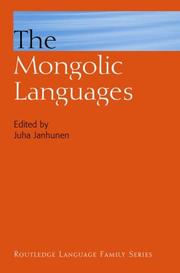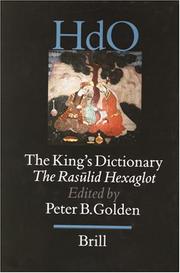| Listing 1 - 5 of 5 |
Sort by
|

ISBN: 1280838396 0191514616 1429469404 9781429469401 9780199260171 0199260176 9780191514616 9786610838394 6610838399 0199260176 9781280838392 0199554277 Year: 2005 Publisher: Oxford Oxford University Press
Abstract | Keywords | Export | Availability | Bookmark
 Loading...
Loading...Choose an application
- Reference Manager
- EndNote
- RefWorks (Direct export to RefWorks)
This book provides both the first comprehensive description of the phonology and phonetics of Standard Mongolian and the first account in any language of the historical phonology of the Mongolian group of languages. - ;This book provides (a) the first comprehensive description of the phonology and phonetics of Standard Mongolian, known as the Halh (Khalkha) dialect and spoken in Ulaanbaatar, the capital of the Republic of Mongolia; and (b) the first account in any language of the historical phonology of the Mongolian group of languages. The synchronic phonology is based on data collected by th
Mongolian language --- Mongolian languages --- Phonology. --- S23/0400 --- Phonology --- Mongolia and the Mongols (including Tannu Tuva, Buriats)--Mongolian languages: general --- Mongolisch --- Phonologie --- Phonetics --- Ural-Altaic languages

ISBN: 1135796904 1280308559 9786610308552 0203987918 9780203987919 9780700711338 0700711333 0700711333 0415681545 9780415681544 9781135796907 9781280308550 6610308551 9781135796853 9781135796891 1135796890 Year: 2003 Publisher: London Routledge
Abstract | Keywords | Export | Availability | Bookmark
 Loading...
Loading...Choose an application
- Reference Manager
- EndNote
- RefWorks (Direct export to RefWorks)
Once the rulers of the largest land empire that has ever existed on earth, the historical Mongols of Chinggis Khan left a linguistic heritage which today survives in the form of more than a dozen different languages, collectively termed Mongolic. For general linguistic theory, the Mongolic languages offer interesting insights to problems of areal typology and structural change. An understanding of the Mongolic language family is also a prerequisite for the study of Mongolian and Central Eurasian history and culture. This volume is the first comprehensive treatment of the Mongolic languages in
Book
ISBN: 9789004168299 900416829X 9786612399336 1282399330 9047443519 9789047443513 Year: 2009 Volume: 19. Publisher: Leiden Boston Brill
Abstract | Keywords | Export | Availability | Bookmark
 Loading...
Loading...Choose an application
- Reference Manager
- EndNote
- RefWorks (Direct export to RefWorks)
The Kitans established the Liao dynasty in northern China, which lasted for over two centuries (916-1125). In this survey the reader will find what is currently known about the Kitan language and scripts. The language was very likely distantly related to Mongolian, with two quite different scripts in use. A few generations after their state was defeated, almost all trace of the Kitan spoken and written languages disappeared, except a few words in Chinese texts. Over the past few decades, however, inscriptions from the tombs of the Liao emperors and the Kitan aristocracy have been at least partially deciphered, resulting in a significant increase of our knowledge of the Kitan lexicon, morphology and syntax.
Khitan language -- Writing. --- Khitan language. --- Altaic languages. --- Altaic languages --- Langues altaïques --- S23/0400 --- S25/0400 --- Mongolia and the Mongols (including Tannu Tuva, Buriats)--Mongolian languages: general --- Xinjiang--Turkish languages --- Langues altaïques --- Chinese language --- Chinois (Langue) --- Writing. --- Ecriture --- Khitan language --- Kitan language --- Liao language --- Mongolian languages --- Morphology. --- Syntax. --- China --- History

ISBN: 9004117695 9789004117693 9789004492585 9004492585 Year: 2000 Volume: 4 Publisher: Leiden Boston Brill
Abstract | Keywords | Export | Availability | Bookmark
 Loading...
Loading...Choose an application
- Reference Manager
- EndNote
- RefWorks (Direct export to RefWorks)
Aden, of old one of the main Eurasian ports for goods from China, Southeast Asia and India on their way to the Mediterranean lands, was controlled during the 13th - 15th centuries by the Rasūlid dynasty. One of their kings, al-Malik al-Afḍal al- 'Abbās b. 'Alī (1363-1377) wrote multilingual glossaries (vocabularia) of extraordinary importance, universally termed the Rasūlid Hexaglot . Its emergence caused quite a stir (e.g. New York Times, February 1981 ), and it is with pride that we now present our customers with the authoritative translation, commentary, and explanation of the socio-historical context by a group of major experts . The Arabic, Persian, Turkic, Greek, Armenian and Mongol languages in the King's Dictionary were the most important tongues of the Eastern Mediterranean. The Greek, Armenian and Mongol sections, in particular, provide one of the few examples of transcriptions of living vernacular forms of the era. Thomas Allsen's captivating chapter on the Eurasian Cultural Context of the dictionary makes clear, i.a., the depth of connections among several Eurasian cultural areas in the aftermath of the Mongol conquests.
Polyglot glossaries, phrase-books, etc. --- Vocabulaires et manuels de conversion polyglottes --- S32/0400 --- S23/0400 --- S25/0410 --- S34/0400 --- Polyglot glossaries, phrase books, etc --- Central Asia--Altaic languages --- Mongolia and the Mongols (including Tannu Tuva, Buriats)--Mongolian languages: general --- Xinjiang--Turkish languages: textbooks and grammar --- Indian subcontinent--Language (incl. sanscrite) --- Polyglot glossaries, phrase books, etc. --- Arabisch --- Dictionaries as Topic --- Méditerranée (région ; est) --- Moyen-Orient --- Dictionnaires polyglottes --- Arabe (langue) --- Langues --- 14e siècle --- Dictionnaires anglais
Book
ISBN: 2890530205 9782890530201 Year: 1980 Publisher: Montréal: L'Aurore,
Abstract | Keywords | Export | Availability | Bookmark
 Loading...
Loading...Choose an application
- Reference Manager
- EndNote
- RefWorks (Direct export to RefWorks)
Langues sino-tibetaines --- Langues tibéto-birmanes --- Sino-Tibetaanse talen --- Sino-Tibetan languages --- Tibeto-Birmaanse talen --- Tibeto-Burman languages --- Tibéto-birmanes [Langues ] --- Chinese language --- East and West --- Asia --- Study and teaching --- Sino-Tibetan languages. --- Chinese language. --- East and West. --- Study and teaching. --- S15/0200 --- S23/0400 --- Indochinese languages --- Tibeto-Chinese languages --- Austroasiatic languages --- Mon-Khmer languages --- Tai-Kadai languages --- Civilization, Western --- Civilization, Oriental --- Occident and Orient --- Orient and Occident --- West and East --- Eastern question --- China: Language--General works --- Asian influences --- Oriental influences --- Western influences --- Oriental philology --- History --- Asia - Study and teaching
| Listing 1 - 5 of 5 |
Sort by
|

 Search
Search Feedback
Feedback About UniCat
About UniCat  Help
Help News
News